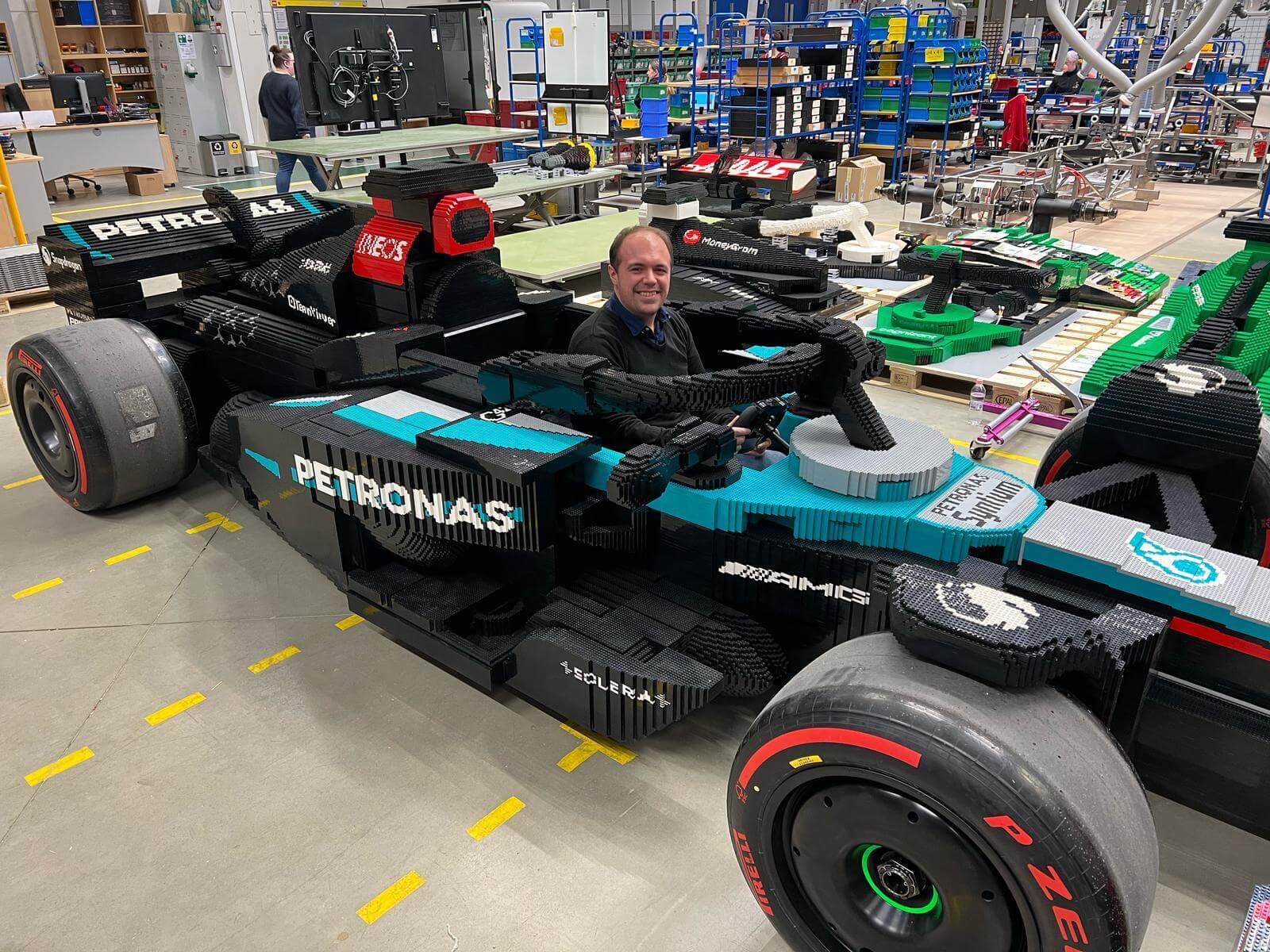
Formula One’s driver parade for the 2025 Miami Grand Prix will surely go down as one of the most memorable in the sport’s recent history.
Ahead of Sunday’s race, the drivers swapped the flatbed truck that usually takes them around the track to wave to the fans for full-size, drivable F1 cars — all built out of Lego.
Advertisement
“That was the most fun drivers’ parade we’ve ever had,” Ferrari’s Lewis Hamilton said. “Some dirty driving from this one here (Gasly)! That was great fun.”
“They’ll have to sweep the track, there’s quite a bit of Lego debris on the track,” Max Verstappen said. “A bit different, that’s for sure!”
With liveries identical to those of their real-world counterparts, this was an ambitious project enacted as part of F1’s partnership with Lego. It was over a year in the making and required tons of bricks to assemble.
In January, The Athletic was granted access to Lego’s ‘big builds’ factory on the outskirts of Prague, Czechia (more widely known in English as the Czech Republic), to see how the cars were built, and even get a chance to jump into the cockpit.
Just setting foot inside Lego’s factory is enough to bring childhood memories flooding back.
Walking around the facility, based in the industrial town of Kladno, offers a peek into Lego’s big projects for the future. Dotted around the central warehouse are many large-scale models that will be used at Lego theme parks, as well as its other top-secret big build projects. Builders sit at work stations with instructions and trays of bricks all around. It’s no different from how kids would build Lego sets, albeit with glue and hammers easily at their disposal.
But taking up a considerable amount of the empty floor space here is a line of F1 cars. They’re being readied to take to the track ahead of the Miami Grand Prix.
Each of the 10 teams has a full-scale F1 car that has been faithfully reconstructed — or, more accurately here, constructed — to look as close to the real-life thing as possible. This requires around 400,000 bricks per car, using the full catalog of Lego bricks. No detail has been skimmed over, down to slightly different part shapes between each team’s cars. Some have skinnier sidepods or a larger sidepod undercut, while even team sponsors have had their logos replicated with the same level of prominence — the text spelled out using the smallest bricks available.
The LEGO McLaren cuts across everybody at Turn 1 but Ferrari come out in front 😱#F1 #MiamiGP pic.twitter.com/AJoINnAQFW
— Formula 1 (@F1) May 4, 2025
Plans for F1 car big builds were first floated in early 2024. When Martin Smida, Lego’s engineering manager specialist, was first asked if it was possible, he said yes — in 2026. But in true F1 fashion, efforts were made to make the impossible possible.
“All our partners, all my colleagues, and all the F1 teams worked perfectly,” Smida said. “For me, it was a surprise how it was possible with so many companies.”
Advertisement
F1 teams are notoriously very secretive about their car designs, but when it came to the Lego recreations, they were more than happy to share as much as possible to make them take accurate shape. This started with Lego’s new Speed Champions product, launched for 2025 featuring small car kits of all 10 teams.
Jonathan Jurion, the project’s senior designer, took these small models as a starting point to build into more complex life-size models. “Once we had that, we transformed that into an upscaled build using our software, working very closely with our mechanical engineers and all the departments to make sure this would be a feasible thing,” he told The Athletic.
Jurion worked with a team of 26 fellow designers and engineers on the project. “We were throwing ideas around,” he said. “I love doing concepts. I’d been asked to do some concepts for that particular thing, and we had a lot of ideas.”
It was the first drivable car that Jurion had worked on for Lego, but not the first time the company had embarked on an ambitious big build for an automotive project. Last year, Lando Norris drove a Lego version of the McLaren P1 supercar around Silverstone. But, as this was constructed using specialized Tecnic bricks that typically strengthen structures by design, instead of the traditional and simple ‘Lego System’ bricks at play here, the F1 cars required a very different approach.
To make the cars sturdy, the 400,000 bricks — weighing about a ton in total — were constructed around a steel frame that weighs another 500 kg. The building team at Kladno glued all the bricks together to provide extra strength, while the car itself was split into five different brick sections (cockpit, engine cover, front wing, rear structure and the halo) to be brought together.
“We had to really streamline the process because we have 10 of them,” said Jurion. “So, we decided to have all of the components integrated into the chassis and then we would build the bricks around it.”
Advertisement
The fact that the cars have to be mobile also presented a challenge to Lego’s designers and engineers, making it far more complicated than a traditional, stationary build that might sit on show for people to admire instead of actually moving.
“First, you need to have an engine (an electric powertrain in this case),” said Smida. “Then after that, you need something to connect to the wheels — a gearbox and a differential. OK, you can start it. But if something starts, you need to stop it. So after that, you need some brakes. And for the first time in this project, we used hydraulic brakes. Once you have the brakes to stop, you need it to be drivable. You need some steering (components) and the steering wheel.”
Smida said the group designed a special steering rack, as they needed one much smaller to fit into F1-sized cockpits compared to full-size road car Lego replicas. He also said Lego worked with a racing brake manufacturer to get brakes that would work sufficiently.
Then came the challenge of getting the drivers — plural — into one car. As seen during the Miami parade lap on Sunday, the cockpits had to be big enough for both drivers from each team to sit inside the car. “We had to tweak it quite a lot to accommodate the second driver,” said Jurion. “We had to make them a little bit longer.”
The second driver sits behind the typical F1 cockpit seating position. For safety reasons, both drivers have seat belts inside the cockpit, even though a decision was also taken to limit the cars to a speed of 12 miles per hour from what is provided by the powertrain.
In total, it took over 2,000 production hours spread across the Lego team in three weeks to construct each car. Once they were complete, they were tested in an underground car park that was big enough to drive the cars around, ensuring they would be strong enough to get around the Miami lap.
The electric powertrain provides a decent getaway, as Smida shows on an open expanse of floor in the Kladno factory. As well as the steering wheel, the cockpits also have a series of switches and buttons that can be used to turn the powertrain on and off.
Naturally, I couldn’t say no to a chance to get into the car and check it out firsthand — even if I wasn’t allowed to drive it.
Just like the actual F1 cars, getting into the cockpit requires careful choreography. First, you step onto the sidepod — trusting my entire body weight on a mass of Lego bricks made me very tentative, but it held up just fine — before stepping onto the seat (thankfully not made out of Lego), then sliding your legs into the footwell.
I couldn’t help but chuckle at the thought of F1 drivers squabbling over who would be allowed to drive and who would be forced to sit awkwardly in the space behind.

Smith’s seating position might impact F1 aerodynamic sensitivities (Lego)
A few weeks after my visit, the cars were packed up and shipped off to Miami. A special Lego garage was put into the fan area at the Hard Rock Stadium so everyone could look at the cars. Ferrari even took its replica into the F1 pit lane.
But the fact these cars were fully drivable was kept under wraps by F1 until the parade itself began, to bring a little extra surprise for all the fans watching.
Advertisement
What was evident from speaking with both Jurion and Smida was the immense pride they felt over the project. For Jurion, a lifelong fan of both Lego and F1, it was the perfect combination of his great passions in life.
“This is a dream come true,” he said. “Seeing them drive the cars will be amazing.”
Top photo: Bryn Lennon – Formula 1/Formula 1 via Getty Images
This news was originally published on this post .







Be the first to leave a comment